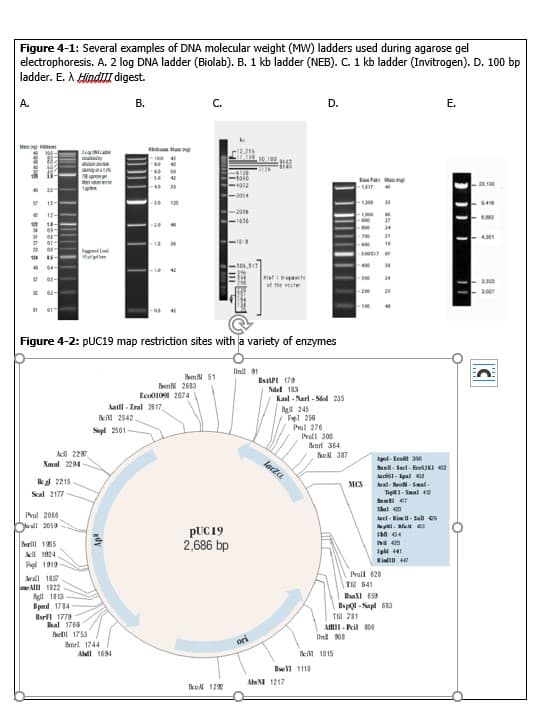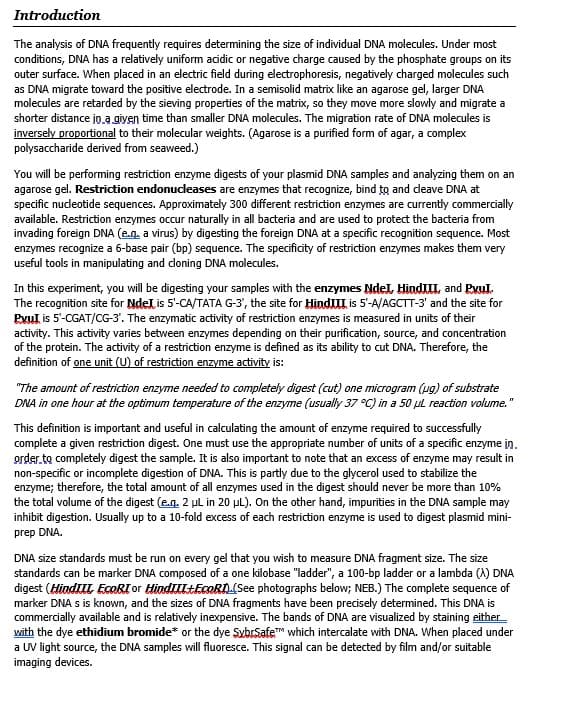What bacteria were used for the isolation of the three enzymes (HindIII, NdeI and PvuI)? What type of ends do these restriction enzymes produce?
What bacteria were used for the isolation of the three enzymes (HindIII, NdeI and PvuI)? What type of ends do these restriction enzymes produce?
Biochemistry
6th Edition
ISBN:9781305577206
Author:Reginald H. Garrett, Charles M. Grisham
Publisher:Reginald H. Garrett, Charles M. Grisham
Chapter28: Dna Metabolism: Replication, Recombination, And Repair
Section: Chapter Questions
Problem 17P
Related questions
Question
100%
- What bacteria were used for the isolation of the three enzymes (HindIII, NdeI and PvuI)? What type of ends do these restriction enzymes produce?
notes are below

Transcribed Image Text:Figure 4-1: Several examples of DNA molecular weight (MW) ladders used during agarose gel
electrophoresis. A. 2 log DNA ladder (Biolab). B. 1 kb ladder (NEB). C. 1 kb ladder (Invitrogen). D. 100 bp
ladder. E. A Hinduu digest.
А.
В.
C.
D.
Е.
Me R
Mas ing
216
tay
ta Mng
4912
23,130
0 20
-2054
15-
-2014
4 12-
-1636
24
7 er
Slt
106,517
iar i ant
f the ecter
2007
Figure 4-2: PUC19 map restriction sites with a variety of enzymes
Dedl 91
hen M 51
Bem 2613
BstAPI 179
Ndel 183
Kasl - Narl - Siol 235
Eco010 2074
Aatll - Zral 2817
Bgll 245
Fel 256
Bkill 2542
Pul 276
Prull 308
Benl 364
Sepl 2501
Al 22
BeN 387
Apel- Ee 306
aall- Sacl - EoekKI 42
Aerts1 - pal 40
Xmal 2204
lacza
kd 2215
Scal 2177
MCS
wal- oN- Smal-
Tip1- Naal 40
n 47
thal
Aecl - Hixl- Sal e0
. al e
Prul 2068
wall 2059
pUC 19
2,686 bp
rl 105
Aell 1924
he as
inin 47
Fl 1919
Prull 628
Aall 187
All 1822
Bgll 1813
Bpnd 1714
T 641
Bull 659
Bspl - Sapl 683
Thil 781
Bsrfl 1779
hal 1765
ell 1753
AI - Peil 06
Dal 208
ori
Bnrl 1744
Alll 1694
kiM 1015
RueYI 1110
AlwNI 1217
RceN 122
1.
書
dy

Transcribed Image Text:Introduction
The analysis of DNA frequently requires determining the size of individual DNA molecules. Under most
conditions, DNA has a relatively uniform acidic or negative charge caused by the phosphate groups on its
outer surface. When placed in an electric field during electrophoresis, negatively charged molecules such
as DNA migrate toward the positive electrode. In a semisolid matrix like an agarose gel, larger DNA
molecules are retarded by the sieving properties of the matrix, so they move more slowly and migrate a
shorter distance jo a giyen time than smaller DNA molecules. The migration rate of DNA molecules is
inversely proportional to their molecular weights. (Agarose is a purified form of agar, a complex
polysaccharide derived from seaweed.)
You will be performing restriction enzyme digests of your plasmid DNA samples and analyzing them on an
agarose gel. Restriction endonudleases are enzymes that recognize, bind to and deave DNA at
specific nudeotide sequences. Approximately 300 different restriction enzymes are currently commercially
available. Restriction enzymes occur naturally in all bacteria and are used to protect the bacteria from
invading foreign DNA (e.g. a virus) by digesting the foreign DNA at a specific recognition sequence. Most
enzymes recognize a 6-base pair (bp) sequence. The specificity of restriction enzymes makes them very
useful tools in manipulating and cloning DNA molecules.
In this experiment, you will be digesting your samples with the enzymes Ndel HindII, and Pvul.
The recognition site for Ndel is 5'-CA/TATA G-3', the site for Hind is 5'-A/AGCTT-3' and the site for
Puul is 5-CGAT/CG-3'. The enzymatic activity of restriction enzymes is measured in units of their
activity. This activity varies between enzymes depending on their purification, source, and concentration
of the protein. The activity of a restriction enzyme is defined as its ability to cut DNA. Therefore, the
definition of one unit (U) of restriction enzyme activity is:
"The amount of restriction enzyme needed to completely digest (cut) one microgram (ug) of substrate
DNA in one hour at the optimum temperature of the enzyme (usually 37 °C) in a 50 pl reaction volume."
This definition is important and useful in calculating the amount of enzyme required to successfully
complete a given restriction digest. One must use the appropriate number of units of a specific enzyme in.
order.to completely digest the sample. It is also important to note that an excess of enzyme may result in
non-specific or incomplete digestion of DNA. This is partly due to the glycerol used to stabilize the
enzyme; therefore, the total amount of all enzymes used in the digest should never be more than 10%
the total volume of the digest (e.n. 2 pl in 20 µL). On the other hand, impurities in the DNA sample may
inhibit digestion. Usually up to a 10-fold excess of each restriction enzyme is used to digest plasmid mini-
prep DNA.
DNA size standards must be run on every gel that you wish to measure DNA fragment size. The size
standards can be marker DNA composed of a one kilobase "ladder", a 100-bp ladder or a lambda (A) DNA
digest (HinduL EcaRI or HindiItEcoRD(See photographs below; NEB.) The complete sequence of
marker DNA s is known, and the sizes of DNA fragments have been precisely determined. This DNA is
commercially available and is relatively inexpensive. The bands of DNA are visualized by staining either
with the dye ethidium bromide* or the dye SybrSafe" which intercalate with DNA. When placed under
a UV light source, the DNA samples will fluoresce. This signal can be detected by film and/or suitable
imaging devices.
Expert Solution
This question has been solved!
Explore an expertly crafted, step-by-step solution for a thorough understanding of key concepts.
This is a popular solution!
Trending now
This is a popular solution!
Step by step
Solved in 2 steps

Knowledge Booster
Learn more about
Need a deep-dive on the concept behind this application? Look no further. Learn more about this topic, biology and related others by exploring similar questions and additional content below.Recommended textbooks for you

Biochemistry
Biochemistry
ISBN:
9781305577206
Author:
Reginald H. Garrett, Charles M. Grisham
Publisher:
Cengage Learning

Biochemistry
Biochemistry
ISBN:
9781305577206
Author:
Reginald H. Garrett, Charles M. Grisham
Publisher:
Cengage Learning